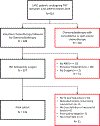MRI radiomics features of mesorectal fat can predict response to neoadjuvant chemoradiation therapy and tumor recurrence in patients with locally advanced rectal cancer
- PMID: 34327580
- PMCID: PMC9018044
- DOI: 10.1007/s00330-021-08144-w
MRI radiomics features of mesorectal fat can predict response to neoadjuvant chemoradiation therapy and tumor recurrence in patients with locally advanced rectal cancer
Abstract
Objective: To interrogate the mesorectal fat using MRI radiomics feature analysis in order to predict clinical outcomes in patients with locally advanced rectal cancer.
Methods: This retrospective study included patients who underwent neoadjuvant chemoradiotherapy for locally advanced rectal cancer from 2009 to 2015. Three radiologists independently segmented mesorectal fat on baseline T2-weighted axial MRI. Radiomics features were extracted from segmented volumes and calculated using CERR software, with adaptive synthetic sampling being employed to combat large class imbalances. Outcome variables included pathologic complete response (pCR), local recurrence, distant recurrence, clinical T-category (cT), post-treatment T category (ypT), and post-treatment N category (ypN). A maximum of eight most important features were selected for model development using support vector machines and fivefold cross-validation to predict each outcome parameter via elastic net regularization. Diagnostic metrics of the final models were calculated, including sensitivity, specificity, PPV, NPV, accuracy, and AUC.
Results: The study included 236 patients (54 ± 12 years, 135 men). The AUC, sensitivity, specificity, PPV, NPV, and accuracy for each clinical outcome were as follows: for pCR, 0.89, 78.0%, 85.1%, 52.5%, 94.9%, 83.9%; for local recurrence, 0.79, 68.3%, 80.7%, 46.7%, 91.2%, 78.3%; for distant recurrence, 0.87, 80.0%, 88.4%, 58.3%, 95.6%, 87.0%; for cT, 0.80, 85.8%, 56.5%, 89.1%, 49.1%, 80.1%; for ypN, 0.74, 65.0%, 80.1%, 52.7%, 87.0%, 76.3%; and for ypT, 0.86, 81.3%, 84.2%, 96.4%, 46.4%, 81.8%.
Conclusion: Radiomics features of mesorectal fat can predict pathological complete response and local and distant recurrence, as well as post-treatment T and N categories.
Key points: • Mesorectal fat contains important prognostic information in patients with locally advanced rectal cancer (LARC). • Radiomics features of mesorectal fat were significantly different between those who achieved complete vs incomplete pathologic response (accuracy 83.9%, 95% CI: 78.6-88.4%). • Radiomics features of mesorectal fat were significantly different between those who did vs did not develop local or distant recurrence (accuracy 78.3%, 95% CI: 72.0-83.7% and 87.0%, 95% CI: 81.6-91.2% respectively).
Keywords: Adipose tissue; Magnetic resonance imaging; Neoadjuvant therapy; Rectal neoplasms.
© 2021. European Society of Radiology.
Conflict of interest statement
Conflict of Interest:
The authors of this manuscript declare relationships with the following companies: Dr. Andrea Cercek reports being on the advisory board of Bayer and Array Biopharma and she has received research funding from Tesaro/GSK, RGenix, and Seattle Genetics.
The remaining authors report no potential conflict of interest.
Figures





References
MeSH terms
Grants and funding
LinkOut - more resources
Full Text Sources

